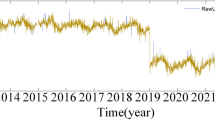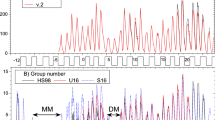Abstract
The numerical prediction of the Earth’s polar motion is of both theoretical and practical interest. The present paper is aimed at a comprehensive, experimental study of the predictability of polar motion using a homogeneous BIH (Bureau International de l’Heure) data set for the period 1967–1983. Based on our knowledge of the physics of the annual and the Chandler wobbles, we build the numerical model for the polar motion by allowing the wobble period to vary. Using an optimum base length of six years for prediction, this “floating-period” model, equipped with a nonlinear least-squares estimator, is found to yield polar motion predictions accurate to within 0″.012 to 0″.024 depending on the prediction length up to one year, corresponding to a predictability of 89–82%. This represents a considerable improvement over the conventional fixed-period predictor, which, by its nature, does not respond to variations in the apparent wobble periods (in particular, a dramatic decrease in the periods of both the annual and the Chandler wobbles after the year 1980). The superiority of the floating-period predictor to other predictors based on critically different numerical models is also demonstrated.
Similar content being viewed by others
References
A.K. BABCOCK: Predicting Earth’s rotation.EOS, Trans. Amer. Geophys. Union, 63, 903, 1982.
P.R. BEVINGTON:Data Reduction and Error Analysis for the Physical Sciences, McGraw-Hill, New York, pp. 336, 1969.
G.E.P. BOX and G.M. JENKINS:Time Series Analysis: Forecasting and Control, Holden-Day, San Francisco, 1970.
N. CAPITAINE and M. FEISSEL: The introduction of the IAU 1980 Nutation Theory in the computation of the Earth rotation parameters by the Bureau Intermational de l’Heure,Bull. Géodésique, 57, pp. 198–204, 1983.
B.F. CHAO: Autoregressive hamonic analysis of the Earth’s polar motion using homogeneous ILS data,J. Geophys. Res, 88, pp. 10299–10307, 1983.
B.F. CHAO: On the maximum entropy/autoregressive modeling of time series,NASA TM 86057, Goddard space Flight Center, 1984.
B.F. CHAO and F. GILBERT: Autoregressive estimation of complex eigenfrequencies in low frequency seismic spectra,Geophys. J. Roy. Astron. Soc., 63, pp. 641–657, 1980.
G. COLOMBO and I.I. SHAPIRO: Theoretical model for the Chandler wobble,Nature, 217, pp. 156–157, 1968.
M. FEISSEL: Determination of the Earth rotation parameters by the Bureau International de l’Heure: 1962–1979.Bull. Géodésique, 54: pp. 81–102, 1980.
K. LAMBECK:The Earth’s Variable Rotation: Geophysical Causes and Consequences. Cambridge Univ. Press, New York, 1980.
J. MAKHOUL: Linear prediction: a tutorial review.Proc. IEEE, 63, pp. 561–580, 1975.
G.U. YULE: On a method of investigating periodicities in disturbed series with special reference to Wolfer’s sunspot numbers,Phil. Trans. Roy. Soc., A, 226, pp. 267–298, 1927.
S.Y. ZHU: Prediction of polar motion,Bull. Géodésique, 56, pp. 258–273, 1982.
Author information
Authors and Affiliations
Rights and permissions
About this article
Cite this article
Chao, B.F. Predictability of the Earth’s polar motion. Bull. Geodesique 59, 81–93 (1985). https://doi.org/10.1007/BF02519342
Received:
Accepted:
Issue Date:
DOI: https://doi.org/10.1007/BF02519342




